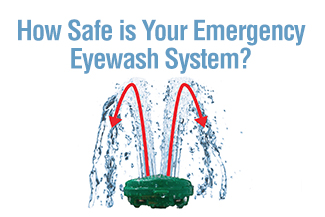When a healthcare worker’s eyes are exposed to harmful chemicals and contaminants, it’s not just every second that counts – it’s also every drop.
Emergency eyewash systems must operate quickly and effectively to minimize injury. Most healthcare professionals are probably familiar with the American National Standards Institute’s (ANSI) requirements regarding emergency eyewash functionality and usage. They include keeping stations in accessible locations within 10 seconds of the hazard and using stations that go from “off” to “on” in one second or less, among several others (see the complete checklist here).
Despite these, eye injury statistics remain staggering. About 2,000 U.S. workers have a job-related eye injury every day that requires medical treatment, according to the National Institute for Occupational Safety and Health (NIOSH).
 Thankfully, revolutionary advancements in eyewash technology are capable of making a significant, positive impact on eye protection and injury prevention.
Thankfully, revolutionary advancements in eyewash technology are capable of making a significant, positive impact on eye protection and injury prevention.
A change in direction
Emergency eyewash systems typically come in portable, plumbed, and bottled styles to suit your facility’s and personnel’s needs. Many of them share a common characteristic: they direct water toward the inner corners of the eye. That’s where the lacrimal puncta, or ocular surface drains, are located.
The lacrimal puncta are nasal cavity entry points. When contaminants are swept toward them, they can be breathed into the lungs or swallowed.
Traditional systems have relied on this method for years. Now, there is a groundbreaking alternative that poses less risk.
Emergency eyewash systems built with new inverted flow technology sweep contaminants outward and away from the vulnerable inner corners of the eye – the method preferred by medical professionals.
Eyes opened
Both healthcare and non-healthcare organizations that have converted to AXION® eye/face wash solutions with inverted flow technology are seeing convincing results.
Monongahela Valley Hospital (MVH) in Monongahela, Pa., selected AXION units after evaluating the scope of emergency products on the market.
“The units work well,” and staffers have found them “easy to start, especially … in a hurry,” said Betty Ritzer, laboratory supervisor for MVH.
Following the eye/face wash unit’s first use, feedback was positive. Ritzer added that findings from weekly safety checks have convinced her of the safety equipment’s high quality.
 The hospitality industry also is turning to AXION’s economical, hassle-free offerings to meet its needs. Extended Stay America in Plano, Texas, went with the faucet-mounted AXION eyePOD® system (shown left). It replaced the hotel’s existing model with no need for additional plumbing. The unit was used to minimize injury after cleaning chemicals splashed into a housekeeper’s eyes.
The hospitality industry also is turning to AXION’s economical, hassle-free offerings to meet its needs. Extended Stay America in Plano, Texas, went with the faucet-mounted AXION eyePOD® system (shown left). It replaced the hotel’s existing model with no need for additional plumbing. The unit was used to minimize injury after cleaning chemicals splashed into a housekeeper’s eyes.
“So far, so good!” said Kelly Perdue, the hotel’s general manager.
MarketLab offers a large selection of AXION emergency eyewash systems, including convenient, cost-effective upgrades that improve existing, traditional flow systems. Check them out all out here.
Thanks for reading. Got questions on AXION emergency eyewash solutions? Please leave them in the comment box below!

